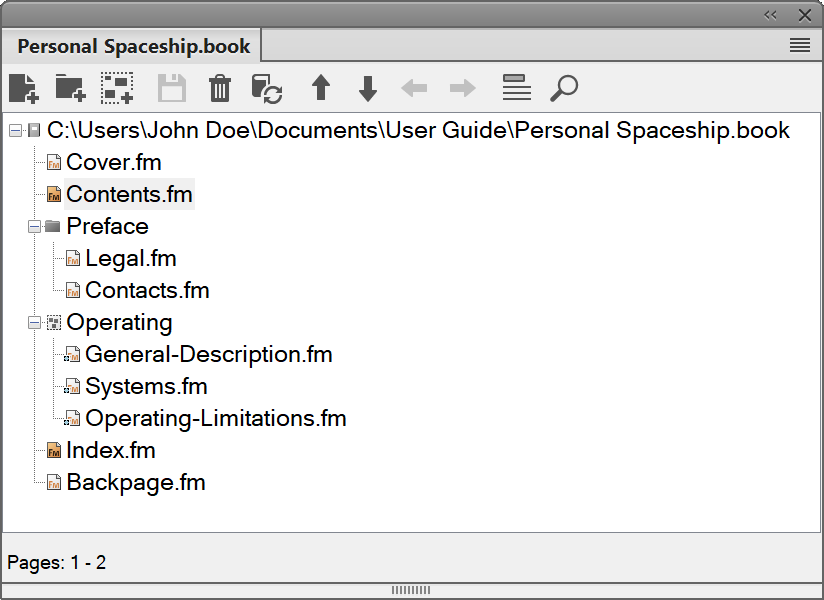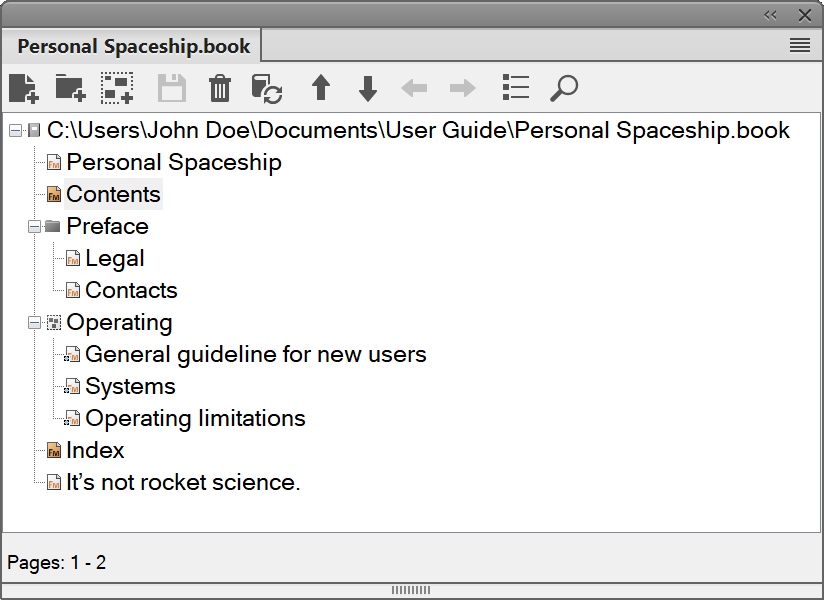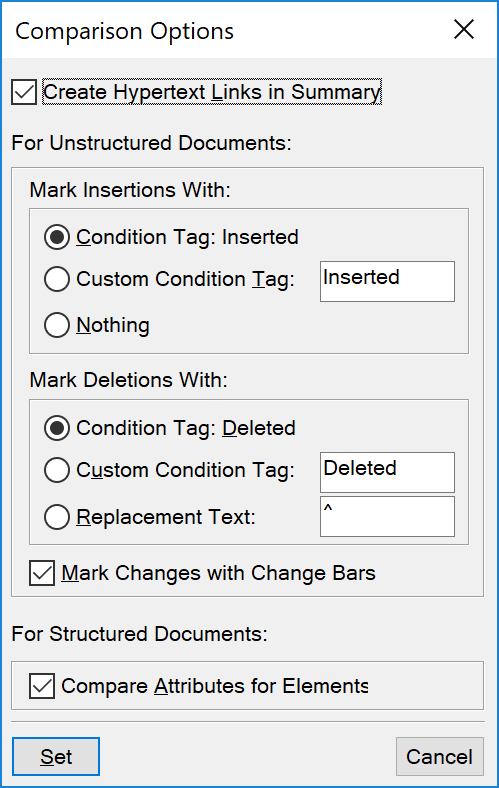Learn how to work with book components in Adobe FrameMaker.
Display filenames or heading text in the book panel
In an Adobe FrameMaker book panel, you can display the filenames or the heading text of a book component:
Click the Display Heading Text icon
 .
.Click the Display File Names icon
 .
.


Exclude book components from the output
Right-click the book component to exclude and select Exclude.
If you exclude a folder or group, Adobe FrameMaker excludes all book components within the folder or group from the output. When you update a book, the numbering is automatically updated to account for the excluded book components.
Select book components
To select certain book component types in an Adobe FrameMaker book, do one of the following:
- Select all book components
Choose .
- Select all generated files in a book
Choose .
- Select all nongenerated files in a book
Choose .
- Select only FrameMaker files, such as .fm, .book, .mif files
Choose .
- Select all excluded book components
Choose .
- Select all the book components that are not marked as Excluded
Choose .
- Select all the book components at the first hierarchical level
Choose .
- Select all book components at the second hierarchical level
Choose .
- Select all book components at the third hierarchical level
Choose .
Rearrange and delete book components in a book
When working with structured books in Adobe FrameMaker, you can rearrange and delete book components by working with element bubbles in the Structure View. After you update the book, the text snippets identify the book components.
If you delete a book component from a structured book you’ve updated, the book component may retain some structure information inherited from the book. Remove this information from the book component to make it a stand-alone document again.
In the book panel, select one or more book components. Do either of the following:
Drag the selected book components to the desired position in the book.
Choose . The book components are removed from the book, but the files remain on the disk.
Rename book components in a book
When you rename a book component, Adobe FrameMaker renames the corresponding file on the disk and updates cross-references, hypertext links, and text inset links in other files in the book.
When you add a generated file (such as a table of contents or index) to a book, FrameMaker assignes a name to the file based on the book’s filename. If you leave generated files with the default filename and rename the book, then FrameMaker changes the filename in the book, but not on disk.
For example, in New.book, you have a generated file with the default name NewTOC.fm:
If you rename the book to Samples.book, FrameMaker renames the generated file to SamplesTOC.fm in the book, but not on the disk.
If you rename the generated file as Contents.fm and then rename the book, the generated TOC remains Contents.fm in the book as well as on disk.
Select the book component you want to rename, and either choose or right-click and choose .
Type the new name of the book component and press Enter. When the alert message appears, click OK to update the other book components in the same book.
Revert to a previously saved version
This procedure affects book components that you have added or deleted in Adobe FrameMaker. It also affects settings that you have applied to book components in the book, such as numbering, pagination, and color definitions. The content of the documents is not changed.
Choose to revert to a previously saved version.
Open, save, or close book components
In Adobe FrameMaker, you can use the book panel to open, save, print, and close individual book component. You can also open, save, and close all the book components and print and update the format of several or all book components.
When you open a non-FrameMaker document from the book panel, the appropriate application, if available, is launched.
Do one of the following:
To open one book component, double-click the book component.
To open several book components, select the book component you want to open and press Enter.
To open all book components, hold down Shift and choose .
To close all book components in a book, hold down Shift and choose .
To save all book components in a book, hold down Shift and choose . This also saves the book file itself.
Compare documents
Adobe FrameMaker can compare two versions of a document to show you what has changed. FrameMaker compares not only the text in the two versions, but also the footnotes, markers, anchored frames, text insets, variables, and cross-references.
Open both versions of the documents.
In the document window of the newer version, choose .
Specify the older version of the document to be compared.
Choose the report format. You can either have a summary document or a composite document.
The summary document reports of the differences in the book components. Composite documents (which have a CMP suffix) show the differences in the files side by side.
- To set up the comparison options, click Options. The options screen is displayed as follows:Figure 3. Comparison Options dialog

Set the options. Click Set.
Click Compare.
The selected reporting format displays the differences. All differences display with track changes, and you can accept or reject the changes as desired.
Apply book-wide commands
You can use many Adobe FrameMaker commands across some or all book components in the same book. For example, you can change the View options, spell-check, or change the page layout of selected book components.
If the book components of the book are open, FrameMaker applies the book-wide command to the book components. Still, the book components are not saved or closed. Therefore, in the case of open book components, you should explicitly save the files before you close them.
If the book components are closed, FrameMaker silently opens the book components, applies the book-wide commands, then saves and closes the book components. If FrameMaker is unable to open a closed file or if other problems occur when you apply the command to a selected file, a message appears in the Book Error Log.
In the book panel, select the book components you want to change.
Choose the desired command, such as .
In structured documents, you can edit attributes, set available elements, and set new element options in the book.